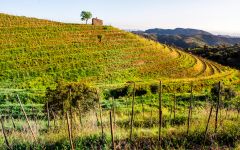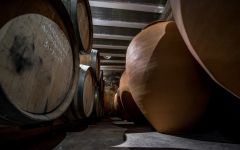Clos i Terrasses Laurel 2018
-
Robert
Parker



Product Details
Your Rating
Somm Note
Winemaker Notes
While Clos Erasmus comes from the same parcels year after year, Laurel has been slowly evolving both in the vineyard and cellar. Laurel is sourced from younger vines of Garnatxa planted on costers in Aubagues, Garnatxa, Syrah, and Cabernet from the warm terroir of Socarrats, and Garnatxa and Syrah from Guinarderes. The final blend is roughly 75% Garnatxa, 20% Syrah, and 5% Cabernet Sauvignon. Based largely on younger vines and years of toil to establish these sites and properly farm them following organic and biodynamic principles, it would be wholly inappropriate to view Laurel as a second wine. If Daphne had not already established herself as one of the most talented vignerons in the Priorat with Clos Erasmus, she would be a leading contender with Laurel. Aged in large oak vats, concrete tanks, second and third fill French oak barrels, and clay amphorae, the complexity of the élevage is reflected in the wine which always shows an ethereal and aromatic complexity, translucent ruby color, with red fruit more than black fruit character buttressed with subtle tannins.
Professional Ratings
-
Robert Parker's Wine Advocate
The second wine here and one that is easier to drink, the 2018 Laurel was produced with fruit from the younger vines, a couple of barrels that are declassified from Clos Erasmus and the Cabernet Sauvignon, more or less 70% Garnacha and 15% each Syrah and Cabernet Sauvignon. It has good ripeness and still a pH of 3.3. It fermented mostly in oak vats and 2,000-liter concrete vats with indigenous yeasts and matured for 18 months in 20,000-liter oak and concrete vats, second use barriques and some clay amphorae. It's a bright translucent ruby color and has a perfumed and delicate nose with notes of orange peel and flowers; this is the most elegant and ethereal vintage of Laurel as far as I can remember, with red rather than black fruit and a kind of cranberry quality. The palate is medium-bodied, textured and fluid, with subtleness, balance and very fine tannins. The oak is perfectly integrated, and the wine is easy to drink, approachable and very pleasurable right now. It's a fresh vintage with energy and finesse, quite different from previous vintages. I love it.
Other Vintages
2020-
Robert
Parker
-
Robert
Parker
-
Robert
Parker
-
Jeb
Dunnuck -
Robert
Parker
-
Robert
Parker -
Jeb
Dunnuck
-
Robert
Parker
-
Robert
Parker
-
Robert
Parker






In 1988 Daphne Glorian, at the time employed by an English Master of Wine in his Paris office, was in the throws of epic folly and spent her life’s savings on 17 terraces of hillside vines just outside the village of Gratallops. Newly minted friends René Barbier and Alvaro Palacios encouraged her and together with Carles Pastrana and Jose Luis Perez, they pooled their talents and resources to make a new style of wine in a region rich in history and raw materials but without much of a proven track record for fine wines. In 1989 the modern Priorat was born: one wine but five different labels, each which would one day become known around the world: Clos Mogador, Clos Dofi, Clos Martinet, Clos de l’Obac and Clos Erasmus.
Today Daphne’s property goes by the name Clos i Terrasses in recognition of the Clos upon which her fame was established and the terraces that she farms. The estate is planted with 75% Garnatxa, 20% Syrah and 5% Cabernet Sauvignon.
The first vineyard, the original folly, is named Escalas. At 1.7 hectares, it is her smallest site planted on seventeen terraces carved out of a steep slope and surrounded by woods. North-facing, its seemingly inauspicious aspect creates the perfect conditions for ripening Garnatxa slowly and nurturing unusually vibrant Syrah, a variety which normally struggles in this hot and arid region.
In the early 1990s Daphne added Aubagues and Socarrats to her holdings. Aubagues is 2.5 hectares in size and like Escalas, it was replanted in the mid 1980s . It has a diverse exposure that spans two ridge tops, so the Garnatxa is grown to take advantage of the warmer parts of the vineyard with its deep soils while Syrah is reserved for the cooler, shallower, north-facing slopes. Even in youth, the Garnatxa from Aubagues is aromatic and inclined towards red fruit flavours.
Socarrats is the largest vineyard, totalling just over 3.5 hectares, where Garnatxa, Syrah and Cabernet Sauvignon are planted up and over a hillside from southeast to northwest. Here her 2500 vines of Cabernet Sauvignon suffer each year, not being suited to the heat and llicorella soil. Each year Daphne resolves to graft them over until she tastes the wine they produce and each year they are granted a reprieve.
It may have begun in folly but through extraordinary effort and a relentlessness that borders on madness, Clos i Terrasses, much like the Priroat, continues to evolve and innovate. It is hard to imagine a world, only a quarter century ago, where wines like the five Clos did not exist but even more remarkable, is imagining what they will become in another quarter century under such talented stewardship.

With hundreds of red grape varieties to choose from, winemakers have the freedom to create a virtually endless assortment of blended red wines. In many European regions, strict laws are in place determining the set of varieties that may be used, but in the New World, experimentation is permitted and encouraged resulting in a wide variety of red wine styles. Blending can be utilized to enhance balance or create complexity, lending different layers of flavors and aromas. For example, a red wine blend variety that creates a fruity and full-bodied wine would do well combined with one that is naturally high in acidity and tannins. Sometimes small amounts of a particular variety are added to boost color or aromatics. Blending can take place before or after fermentation, with the latter, more popular option giving more control to the winemaker over the final qualities of the wine.
How to Serve Red Wine
A common piece of advice is to serve red wine at “room temperature,” but this suggestion is imprecise. After all, room temperature in January is likely to be quite different than in August, even considering the possible effect of central heating and air conditioning systems. The proper temperature to aim for is 55° F to 60° F for lighter-bodied reds and 60° F to 65° F for fuller-bodied wines.
How Long Does Red Wine Last?
Once opened and re-corked, a bottle stored in a cool, dark environment (like your fridge) will stay fresh and nicely drinkable for a day or two. There are products available that can extend that period by a couple of days. As for unopened bottles, optimal storage means keeping them on their sides in a moderately humid environment at about 57° F. Red wines stored in this manner will stay good – and possibly improve – for anywhere from one year to multiple decades. Assessing how long to hold on to a bottle is a complicated science. If you are planning long-term storage of your reds, seek the advice of a wine professional.

Tiny and entirely composed of craggy, jagged and deeply terraced vineyards, Priorat is a Catalan wine-producing region that was virtually abandoned until the early 1990s. This Spanish wine's renaissance came with the arrival of one man, René Barbier, who recognized the region’s forgotten potential. He banded with five friends to create five “Clos” in the village of Gratallops. Their aim was to revive some of Priorat’s ancient Carignan vines, as well as plant new—mainly French—varieties. These winemakers were technically skilled, well-trained and locally inspired; not surprisingly their results were a far cry from the few rustic and overly fermented wines already produced.
This movement escalated Priorat’s popularity for a few reasons. Its new wines were modern and made with well-recognized varieties, namely old Carignan and Grenache blended with Syrah, Cabernet Sauvignon and Merlot. When the demand arrived, scarcity commanded higher prices and as the region discovered its new acclaim, investors came running from near and far. Within ten years, the area under vine practically doubled.
Priorat’s steep slopes of licorella (brown and black slate) and quartzite soils, protection from the cold winds of the Siera de Monstant and a lack of water, leading to incredibly low vine yields, all work together to make the region’s wines unique. While similar blends could and are produced elsewhere, the mineral essence and unprecedented concentration of a Priorat wine is unmistakable.
